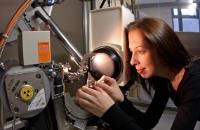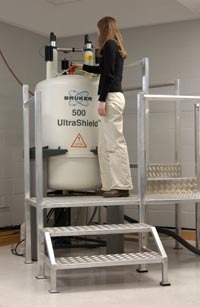Major Facilities
The Department of Chemistry at Memorial has extensive modern research facilities. Researchers in chemistry are able to make use of instruments across the university through the CREAIT network.
X-Ray Diffraction

Memorial has its own single-crystal and powder X-ray diffractometers. In a typical year, this facility is used to determine the structure of about 100 molecules or materials. Many students in the department have been trained to collect and solve diffraction patterns as part of their own research.
NMR Spectroscopy

Professor Celine Schneider manages the NMR facility at Memorial. This facility provides excellent solution and solid-state NMR services to the department. Three spectrophotometers are available,
- Bruker AVANCE II 600 MHz
- Bruker AVANCE 500 MHz
- Bruker AVANCE III 300 MHz
Mass Spectrometry
The analytical facilities available in the Department of Chemistry are world class, and among the best in the country. Some of the instrumentation is owned by individual researchers (e.g. HPLCs, gel permeation chromatography systems for polymer characterization, pyrolysis GC-MS, etc.), however much of the equipment is run either by the Department or is part of C-CART and is accessible for hands-on use by any students in chemistry at Memorial.
We are particularly well equipped in the area of mass spectrometry. There are two HPLC-MS systems, one with a single quadrupole with an available capillary electrophoresis front end, and one with a quadrupole ion trap; both have on board UV-Vis diode array detectors. We are one of the only Departments in Canada with an LC-MS/MS with a DESI interface, which was purchased early in 2013 as part of an ACOA-Atlantic Innovation Fund project. There are two GC-MS systems (one being a time of flight system for accurate mass determinations), and a MALDI-TOF/TOF MS system.
FT-ICR Mass Spectrometry
The Laboratory for the Study of the Energetics, Reactions, and Structures of Gaseous Ions houses a Bruker Apex Qe70 Fourier transform ion cyclotron resonance mass spectrometer (FT-ICR MS). Electrosprayed ions are mass selected, trapped, and isolated, then studied using a host of methods that take advantage of the tandem MS capabilities of the FT-ICR MS. Ion activation and fragmentation techniques such as collision induced dissociation and CO2 laser infrared multiple photon dissociation (IRMPD), gas phase ion-molecule reactions, blackbody-infrared radiative dissociation, and IRMPD spectroscopy are some of the techniques used by researchers in the Fridgen group to study metal cation complexes of amino acids, peptides, DNA bases, carbohydrates, and their microsolvated analogues.
Laser Spectroscopy
2 Raman microscopes (Renishaw InVia, 640 nm and 830 nm excitation).
Atomic Force Microscopy
Our Atomic Force Microscopy (AFM) facility allows us to characterize the surfaces of materials. We have an Asylum Research MFP-3D AFM with heating stage, ORCA. (conductive AFM: MFM, capacitive, Kelvin force microscopy, etc).
Centre for Green Chemistry and Catalysis
The Centre for Green Chemistry and Catalysis is housed in recently refurbished laboratory space. Research group members have immediate access to three large inert atmosphere workstations, two microwave reactor systems, multiple pressure vessels, a supercritical fluid phase monitor, a GC-MS, a GPC, a UV-Vis/NIR spectrometer, an ultrasound bath and probe, and many other pieces of equipment in our lab space. Green Chemistry researchers also make extensive use of instruments housed within CREAIT including the 600 MHz NMR spectrometer (for solid-state studies), X-ray diffractometers (both single crystal and powder instruments), ICP-MS (for determination of trace catalyst residues), and DSC and TGA (for thermal properties of new polymers).
Computational Chemistry
The headquarters of ACEnet, the supercomputing consortium serving Atlantic Canada, is located at Memorial. This facility hosts the 3740 processor Placentia supercomputing cluster, which is the largest facility within ACEnet. ACEnet is a member of the Compute Canada consortium, which allows researchers at Memorial to make use of supercomputing facilities across Canada. Please see the web page Computational Chemistry at Memorial for more details.
Micro/Nanofabrication Facilities
Suite of photolithography and reactive ion etching (RIE) equipment, including inert atmosphere chamber for silanization and dedicated infrastructure for non-photoresist ("clean") polymer patterning. A new, dedicated clean room is under construction.
Centre for Chemical Analysis: Research and Training (C-CART)
The Centre for Chemical Analysis provides analytical resources for research and development across the university and the province, as well as training of highly qualified personnel. The centre features modern instruments for seven service areas: nuclear magnetic resonance (NMR), x-ray crystallograpphy, mass spectrometry, chromatography, capillary electrophoresis, infrared and inorganic analysis. Instrumentation related to each area is described below:
Capillary Electrophoresis
An Agilent 1602 capillary eleoctrophoresis system with a UV-visible diode-array detector and a 48-position carousel autosampler/fraction collector is available. The instrument can also be interfaced with the Agilent 1100 series MSD.
Infrared Spectrometer
A Bruker TENSOR 27 FT-IR is available that can run liquid and solid samples. Software for spectral analysis and data processing is also available.
Chromatography
The Agilent 1100 series LC/MS and an HP 5970 GC/MSD are available.
Inorganic Analysis
Several instruments are available for inorganic analysis. These include a Varian SpectrAA-55 double beam flame atomic absorption spectrometer with a wide selection of available lamps, a Varian SpectrAA Zeeman graphite furnace atomic absorption spectrometer, and a BAS 100B/W Electrochemical Workstation.